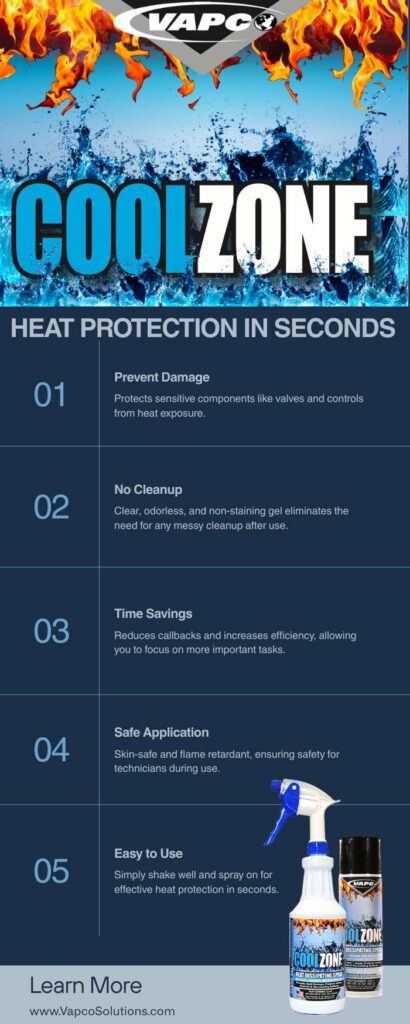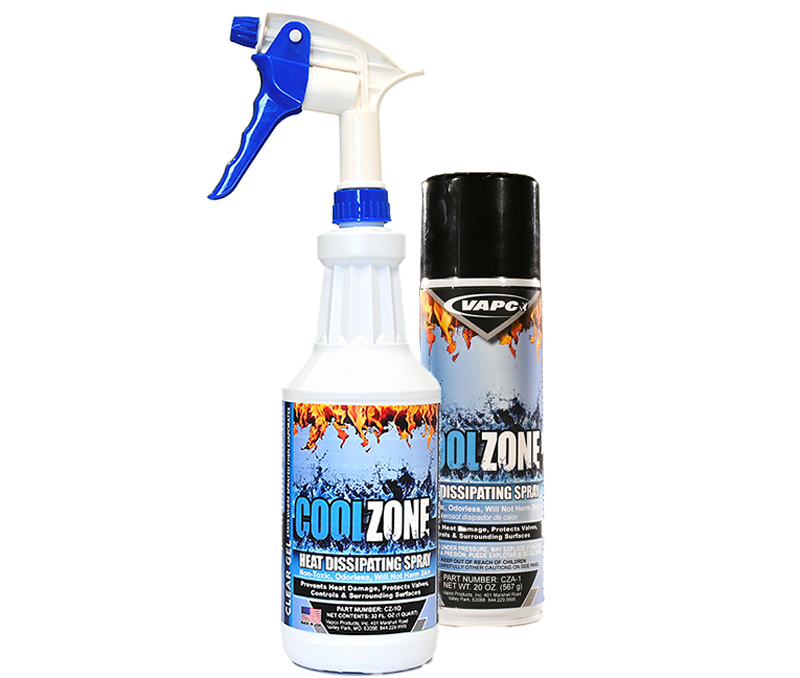HVAC Heat Protection Gel: Stop Heat Damage Cold with COOL ZONE

Brazing, soldering, and welding are daily realities for the professional HVAC contractor, but they bring an inherent risk: heat damage to sensitive components. From pricey control fittings to nearby wiring and materials, a momentary slip can lead to costly callbacks and lost time. Enter COOL ZONE, the specialized HVAC heat protection gel designed to safeguard your work, simplify your job, and protect your bottom line.
Why COOL ZONE is the Only HVAC Heat Protection Gel You Need
Stop Component Damage Cold! See why COOL ZONE is the essential HVAC heat protection gel for every contractor’s toolkit. Protect sensitive valves, eliminate messy cleanup, and braze with total confidence.
Key Benefits for the Professional Contractor
Total Component Defense: The Ultimate Thermal Shield
When brazing or soldering, the risk of overheating sensitive parts is constant. COOL ZONE addresses this with a thick, stable formula that acts as an instant thermal shield, making it an essential HVAC heat protection gel for every job.
Protects High-Value Components: It’s engineered to stop heat migration, protecting expensive components like TXVs (Thermostatic Expansion Valves), solenoid valves, electrical wiring harnesses, and digital control boards from heat damage. By isolating the work area, you ensure that internal seals and plastics remain below their critical temperature threshold, preventing immediate failure and costly callbacks.
Effective Heat Sink: Simply spray COOL ZONE directly onto the components and surrounding copper tubing. Its high thermal capacity draws heat away from the brazing point, keeping materials cool and stable. This targeted heat isolation lets you focus on creating a perfect, leak-free joint without worrying about collateral damage.
No Mess, No Fuss: Quick, Easy Cleanup, Maximum Efficiency
For the busy contractor, time spent on cleanup is money lost. COOL ZONE makes post-braze cleanup quick and easy, setting this HVAC heat protection gel apart from paste alternatives and other formulas.
Non-Staining and Residue-Free: COOL ZONE is clear, odorless, and completely non-staining. Unlike wet rags that leave moisture or putty-based products that crumble or crust, this gel wipes away easily without the need for water or chemical cleaners. It won’t pop or leave behind a sticky residue—and if a small portion is missed, it doesn’t dry into a flaky white residue that creates a larger mess—ensuring a clean, professional finish every time.
Boosts Job Speed: There can be cleanup with COOL ZONE, but it’s inherently easier than other formulas on the market. Because cleanup is as simple as a quick wipe—no water or chemicals required—and there’s no need to scrape or rinse the work area after the braze cools, your crew can immediately move on to the next task or the next job. This easy-wipe feature translates directly into faster project completion and higher daily productivity.
Skin-Safe and Flame-Retardant: Safety is Paramount
Safety on the job site is non-negotiable, and COOL ZONE offers protection not only for components but for the workspace and the user.
Reduced Fire Risk: The formula is designed to be flame-retardant, offering a critical layer of defense. When applied to surrounding flammable materials like insulation, wood, or even plastic vents, this HVAC heat protection gel helps reduce the risk of fire ignition from stray heat or sparks, providing peace of mind in tight, potentially hazardous work areas. The COOL ZONE aerosol in particular is great for application on drywall, joists, and other flammable materials around where a contractor might be working in tight spaces in basements or attics. Both the aerosol and the trigger sprayer can easily coat pipes and fittings; choose the aerosol when you need broad, even coverage on walls, joists, insulation, or other combustible or sensitive surfaces—especially in tight spaces.
Safe for Handling: COOL ZONE is completely skin-safe, allowing contractors to handle and apply the product without concern for irritation. This feature avoids the need for special handling procedures and makes it a user-friendly part of your daily safety protocol.
The Real Cost of Skipping Heat Protection: Dangers of Brazing Without COOL ZONE
When a contractor bypasses using a dedicated solution like this HVAC heat protection gel, they expose themselves and their clients to significant risks that ultimately erode profitability and reputation:
- Component Failure and Callbacks: The most common danger is heat damage to internal control mechanisms, solenoids, or thermostatic expansion valves (TXVs). Heat can warp, melt, or instantly destroy these sensitive parts, leading to immediate system failure and requiring expensive, time-consuming callbacks and replacements.
- Structural and Aesthetic Damage: Unprotected heat can scorch paint, melt insulation or wiring sheathing, or even crack or discolor nearby plastic fittings and dashboards. These damages create a messy, unprofessional appearance and can compromise the integrity of the system and its environment.
- Fire Risk: Working in tight spaces, especially near attic insulation, wood framing, or older wiring, dramatically increases the risk of fire. While temporary heat shields exist, only a flame-retardant HVAC heat protection gel provides a barrier that actively helps reduce the chance of flame ignition on nearby materials.
- Choosing COOL ZONE isn’t just about protection—it’s about professional accountability and mitigating the tangible financial risks associated with heat work.
When you’re dealing with costly replacements and tight schedules, choosing the right HVAC heat protection gel is a simple decision. COOL ZONE provides reliable, stable heat resistance, ensuring that every job is clean, protected, and profitable.
Are You Taking Unnecessary Risks? See the real costs of skipping a dedicated HVAC heat protection gel. From component failure to fire risk, protect your reputation and your profit with COOL ZONE.
Frequently Asked Questions (FAQ)
Q: What is COOL ZONE primarily used for in HVAC applications?
- Q: What is COOL ZONE primarily used for in HVAC applications?
A: COOL ZONE is a specialized heat protection gel (heat sink) designed to shield sensitive components, such as valves, control fittings, wiring, and surrounding materials, from the high temperatures generated during brazing, soldering, and welding. - Q: Will COOL ZONE stain or leave a residue on copper or surrounding materials?
A: No. One of the primary benefits of COOL ZONE is its clear, odorless, and non-staining formula. It will not pop during heating or leave behind a crusty mess. Cleanup is simple—just wipe it away; no water or chemical cleaners are needed. And if a small portion is missed, it won’t dry into a flaky white residue that creates a larger mess. - Q: How do I apply the HVAC heat protection gel?
A: Simply shake the container well and spray directly on the surface or components you wish to protect from heat. Ensure the surface is covered completely. Reapply as necessary for prolonged or repeated heating. Both the aerosol and the trigger sprayer make it easy to coat pipes and fittings; use the aerosol when you need to blanket surrounding materials like walls, joists, insulation, or other combustible/sensitive surfaces, and use the trigger sprayer for more targeted application on components. The aerosol format is especially convenient for coating drywall, joists, and other flammable materials in tight spaces such as basements and attics. - Q: Is COOL ZONE safe to handle?
A: Yes, COOL ZONE is designed to be skin-safe and will not cause irritation during handling. - Q: Does COOL ZONE provide any fire safety benefits?
A: Yes. In addition to its heat resistance, COOL ZONE is flame retardant, which helps reduce the risk of fire to nearby combustible materials, adding an extra layer of job-site safety. - Q: What’s the difference between the aerosol and trigger sprayer formats?
- A: Both formats coat pipes and fittings quickly and effectively. The aerosol excels when you need broad, even coverage on surrounding materials—walls, joists, insulation, and other combustible or sensitive surfaces—especially in tight spaces like basements and attics. The trigger sprayer offers precise, controlled application on components and small areas, helping minimize overspray and product waste.
- Q: Can COOL ZONE be used for plumbing and electrical applications?
A: Yes. For plumbing, COOL ZONE is excellent when sweating or brazing near finished surfaces, valve bodies, escutcheons, and PEX transition fittings—apply it to adjacent components and materials to minimize heat transfer and surface damage. It wipes away easily without water or chemicals and won’t leave a flaky white residue if a small amount is missed. For electrical, use COOL ZONE to help shield nearby combustible materials, wire insulation, harnesses, junction boxes, and plastic enclosures from incidental heat and sparks during hot work. Always de-energize circuits and follow local codes and safe work practices. The aerosol format is especially convenient for reaching tight spaces behind walls, in crawl spaces, basements, and attics.
Choosing COOL ZONE isn’t just about protecting your current job; it’s about sticking to the highest professional HVAC service quality standards set by industry leaders like ACCA. By mitigating the need for costly rework, you significantly reduce the risk of replacing expensive control mechanisms (like TXVs and circuit boards). Always ensure your practices, including the use of an effective heat barrier, align with all current guidelines for safe soldering and brazing in HVAC hot work.
Check out more What’s New in HVAC articles here: Full Archive: https://whatsnewinhvac.com/full-archive/
Occupational Safety and Health Administration (OSHA) – This is the core US regulation on welding, cutting, and brazing. It details fire prevention measures, including: “guards shall be used to confine the heat, sparks, and slag,” and “combustibles shall be protected with flameproofed covers or otherwise shielded with metal or asbestos guards or curtains.” This establishes a regulatory requirement for a heat barrier.
Link:
https://www.osha.gov/laws-regs/regulations/standardnumber/1910/1910.252
University of Tennessee (EHS): Welding, Cutting, & Brazing–Provides clear guidance on hot work safety, including the need to “Protect nearby personnel against heat, sparks, etc.”and to “Determine the combustible materials… present or likely to be present in the work area.” This emphasizes the professional obligation to shield the work environment.
Link:
https://www.osha.gov/laws-regs/regulations/standardnumber/1910/1910.252



